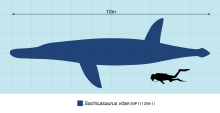Sachicasaurus
| Sachicasaurus Temporal range: Barremian
~ | |
|---|---|

| |
| Holotype specimen of Sachicasaurus. | |
| Scientific classification | |
| Domain: | Eukaryota |
| Kingdom: | Animalia |
| Phylum: | Chordata |
| Class: | Reptilia |
| Superorder: | †Sauropterygia |
| Order: | †Plesiosauria |
| Family: | †Pliosauridae |
| Subfamily: | †Brachaucheninae |
| Genus: | †Sachicasaurus |
| Species: | †S. vitae
|
| Binomial name | |
| †Sachicasaurus vitae Páramo Fonseca et al., 2018
| |
Sachicasaurus is an extinct genus of brachauchenine pliosaurid known from the Barremian of the Paja Formation, Altiplano Cundiboyacense in the Colombian Eastern Ranges of the Andes. The type species is S. vitae.
Etymology
[edit]The genus name Sachicasaurus refers to Sáchica, the location where the fossil was found, and saurus, meaning "lizard" in Latinised Greek. The species epithet vitae, meaning "of life" in Latin, was chosen because of the life in Sáchica the fossil find has sparked.[1]
Description
[edit]
Sachicasaurus was a large pliosaur, with the type specimen measuring approximately 10 metres (33 ft) long and weighing 15 metric tons (17 short tons).[1][2] The holotype specimen, MP111209-1, was found in 2013 and is known from a near complete skull, and postcranial elements including a complete hindlimb and various vertebrae. Diagnostic features include a very short mandibular symphysis, reduced number of mandibular teeth (17 to 18 versus 25 to 40 in other pliosaurids), slender teeth, among other features. With a preserved length of 9.9 metres (32 ft) (which may be missing the vertebrae from the end of the tail), the specimen is interpreted as a sub-adult individual.[1] It is one of the largest and most complete pliosaurid specimens.[3]
Paleoenvironment
[edit]Sachicasaurus is one of four pliosaurids from the Paja Formation, others being Acostasaurus,[4] Stenorhynchosaurus,[5] and Monquirasaurus.[6] It is also contemporaneous with the elasmosaurids Callawayasaurus and Leivanectes,[7] the marine turtle Desmatochelys padillai,[8] the sandowniid turtle Leyvachelys,[9] and the ophthalmosaurid ichthyosaurs Muiscasaurus and Kyhytysuka.[10][11]
References
[edit]- ^ a b c Páramo Fonseca, María Eurídice; Benavides Cabra, Cristian David; Gutiérrez, Ingry Esmirna (2018). "A new large pliosaurid from the Barremian (Lower Cretaceous) of Sáchica, Boyacá, Colombia". Earth Sciences Research Journal. 22 (4): 223–238. doi:10.15446/esrj.v22n4.69916. S2CID 135054193.
- ^ Zhao, R.J. (2024). "Body reconstruction and size estimation of plesiosaurs". bioRxiv 10.1101/2024.02.15.578844.
- ^ N. G. Zverkov, E. M. Pervushov (2020). "A gigantic pliosaurid from the Cenomanian (Upper Cretaceous) of the Volga Region, Russia". Cretaceous Research. 110. Bibcode:2020CrRes.11004419Z. doi:10.1016/j.cretres.2020.104419.
- ^ Gómez Pérez & Noè, 2017
- ^ Páramo et al., 2016
- ^ Noè, L.F.; Gómez-Pérez, M. (2021). "Giant pliosaurids (Sauropterygia; Plesiosauria) from the Lower Cretaceous peri-Gondwanan seas of Colombia and Australia". Cretaceous Research. 132: 105122. doi:10.1016/j.cretres.2021.105122.
- ^ Páramo Fonseca et al., 2019
- ^ Cadena et al., 2015a
- ^ Cadena et al., 2015b
- ^ Maxwell et al., 2015
- ^ Cortés, D.; Maxwell, E.E.; Larsson, H.C.E. (2021). "Re-appearance of hypercarnivore ichthyosaurs in the Cretaceous with differentiated dentition: revision of Platypterygius sachicarum (Reptilia:Ichthyosauria, Ophthalmosauridae) from Colombia". Journal of Systematic Palaeontology. 19 (14): 969–1002. Bibcode:2021JSPal..19..969C. doi:10.1080/14772019.2021.1989507. S2CID 244512087.
Bibliography
[edit]- Sachicasaurus
- Páramo Fonseca, María Eurídice; Benavides Cabra, Cristian David; Gutiérrez, Ingry Esmirna (2018), "A new large pliosaurid from the Barremian (Lower Cretaceous) of Sáchica, Boyacá, Colombia", Earth Sciences Research Journal, 22 (4): 223–238, doi:10.15446/esrj.v22n4.69916, retrieved 2019-03-09
- Other paleofauna
- Cadena, Edwin A.; Parham, James F. (2015a), "Oldest known marine turtle? A new protostegid from the Lower Cretaceous of Colombia", PaleoBios, 32: 1–42, doi:10.5070/P9321028615, retrieved 2017-03-30
- Cadena, Edwin (2015b), "The first South American sandownid turtle from the Lower Cretaceous of Colombia", PeerJ, 3: e1431, doi:10.7717/peerj.1431, PMC 4690369, PMID 26713227
- Gómez Pérez, Marcela; Noè, Leslie F. (2017), "Cranial anatomy of a new pliosaurid Acostasaurus pavachoquensis from the Lower Cretaceous of Colombia, South America", Palaeontographica Abteilung A, 310 (1–2): 5–42, Bibcode:2017PalAA.310....5G, doi:10.1127/pala/2017/0068, retrieved 2019-03-09
- Maxwell, Erin E.; Dick, Daniel; Padilla, Santiago; Parra, Mary Luz (2015), "A new ophthalmosaurid ichthyosaur from the Early Cretaceous of Colombia", Papers in Palaeontology, 2: 59–70, doi:10.1002/spp2.1030, retrieved 2017-03-30
- Páramo Fonseca, María Euridice; O'Gorman, José Patricio; Gasparini, Zulma; Padilla, Santiago; Parra Ruge, Mary Luz (2019), "A new late Aptian elasmosaurid from the Paja Formation, Villa de Leiva, Colombia", Cretaceous Research, 99: 30–40, Bibcode:2019CrRes..99...30P, doi:10.1016/j.cretres.2019.02.010, hdl:11336/127809, retrieved 2019-03-09
- Páramo, María E.; Gómez Pérez, Marcela; Noé, Leslie F.; Etayo, Fernando (2016), "Stenorhynchosaurus munozi, gen. et sp. nov. a new pliosaurid from the Upper Barremian (Lower Cretaceous) of Villa de Leiva, Colombia, South America", Revista de la Academia Colombiana de Ciencias Exactas, Físicas y Naturales, 40 (154): 84–103, doi:10.18257/raccefyn.239, retrieved 2017-04-20
External links
[edit]- "Genus: Sachicasaurus". paleofile.com. Archived from the original on November 1, 2023.










